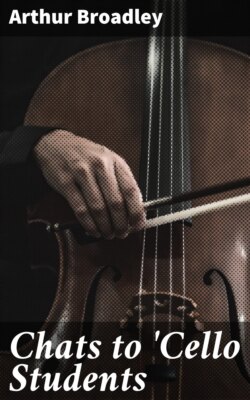Читать книгу Chats to 'Cello Students - Arthur Broadley - Страница 9
На сайте Литреса книга снята с продажи.
Attitude of the Player.
ОглавлениеTable of Contents
Most pupils are surprised I have no doubt, at the evident discrepancy seen in the plates usually published with 'cello schools, when compared with the manner in which our first class artists hold their instruments. I will endeavour in some measure to explain this away.
The correct way to hold the 'cello if the instrument is not fitted with a sliding pin is as follows. The player to sit on the front part of the chair with the feet advanced, the left a little more forward than the right. The 'cello to be held with the legs, the lower part of the front edge (table) of the instrument being held in position by the right calf—the edge of the back being supported by the left calf—the legs of the player not to cover the ribs of the instrument so that the vibration is not impeded. The upper part of the back to the right of where the neck of the instrument is fitted should rest against the chest of the performer, this will throw the scroll of the instrument a little to the left of the face. The instrument to be held high enough for the bowing to clear the knees of the player. The thumb to be placed in a horizontal position at the back of the neck of the instrument, and should be between the first and second fingers. The left elbow not to be raised. This then is the correct manner of holding the 'cello. If the reader will look at the plate which is published with either the Kummer or the Seb. Lee instruction book, he will find that the figure there agrees with the foregoing rules in every particular.
If the student makes use of a sliding-pin these instructions cannot be observed in every respect, the legs are not required to hold the 'cello, the left knee alone being brought into use as a slight support—not to hold the instrument from the ground, but to prevent it from rocking backwards and forwards.
Fig 1.
In this matter I would like the student to understand that attitude does not assist in the production of music, but do not let the reader imagine that if unnecessary posing does not help, awkward and uncouth positions of the players do not take away from the effect. Anything which distracts the attention of the audience from the music should be rigidly avoided; awkward attitudes, and grotesque motions of the head and body should therefore be instantly suppressed by the teacher or the private friends of the student.
Piatti, who does not use a 'cello peg, holds his instrument in a correct manner, not shuffling about or varying his position. Now if the reader ever has a chance of hearing Van Biene, let him observe the manner in which that artist holds his 'cello. We have here the two extremes; as Piatti is of the strictly correct order, Van Biene is of the exaggerated artistic order, all the time he is playing constantly striking some fresh attitude. If Van Biene had again to take to concert work, I have no doubt that he would calm down a little in this respect, his exaggerated style while being very effective on the stage, would not be tolerated on the concert platform. By all means let the student use a sliding-pin, but let him take advantage of the greater facilities which are offered, to make his attitude more artistic, always adopting the happy medium in this matter at least, correctness—without awkwardness, artistic grace—without unnecessary vain posing. As a first class elocutionist seeks by attitude to help the effect of his words, not to distract the attention of his audience, so the attitude of the 'cellist must be pleasing and easeful. If the student will compare (Fig. 1) with the plates usually published with 'cello schools, especially the two previously mentioned, he will see the importance of the matter.
